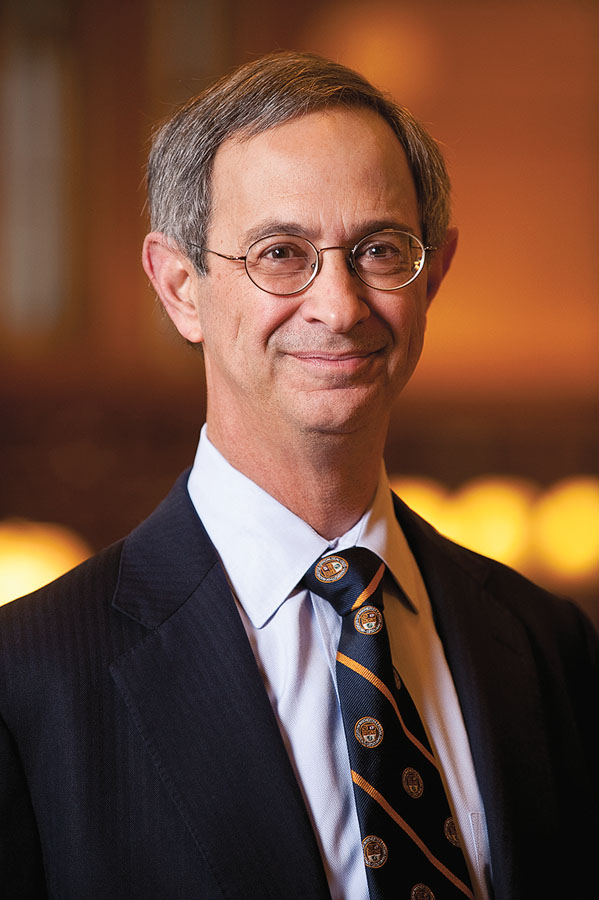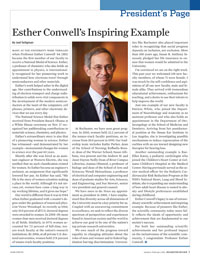President's Page
 (Photo: Adam Fenster)
(Photo: Adam Fenster)Many at the University were thrilled when Professor Esther Conwell ’44 (MS) became the first member of our faculty to receive a National Medal of Science. Esther, a professor of chemistry who also holds an appointment in physics, is internationally recognized for her pioneering work to understand how electrons travel through semiconductors and other materials.
Esther’s work helped usher in the digital age. Her contributions to the understanding of electron transport and charge redistribution in solids were vital components in the development of the modern semiconductors at the heart of the computers, cell phones, printers, and other electronic devices that we use every day.
The National Science Medal that Esther received from President Barack Obama at a White House ceremony on Nov. 17 recognized her pathbreaking contributions to materials science, chemistry, and physics.
Esther’s extraordinary story is also that of a pioneering woman in science. Esther has witnessed—and demonstrated by her example—monumental changes for women in science over the past 60 years. Shortly after she was hired as an assistant engineer at Western Electric, she was notified that no such classification existed for women. So Esther became an engineer’s assistant, an assignment that significantly lowered her pay. As Esther has said, “My life is the story of women scientists making a place in the world. Although it’s not nirvana yet, women have come a long way in my working lifetime, and it gives me hope.”
Our world is different than it was in 1944 when Esther graduated with a master’s degree under the guidance of renowned physicist Victor Weisskopf. As recently as 1960, only 10.5 percent of all U.S. doctoral degrees were awarded to women. In 2008–09, more women than men received doctoral degrees in all fields.
Similarly, in 1979, women accounted for 7.5 percent of full-time, tenure-track faculty at the nation’s research institutions. By 2006, at all private U.S. doctoral universities, women held 27.8 percent of tenure-track faculty positions.
At Rochester, we have seen great progress. In 2010, women held 32.2 percent of the tenure-track faculty positions, an increase from 20.8 percent in 1990. Our leadership team includes Kathy Parker, dean of the School of Nursing; Raffaella Borasi, dean of the Warner School; Susan Gibbons, vice provost and the Andrew H. and Janet Dayton Neilly Dean of River Campus Libraries; Joanna Olmsted, a professor of biology and dean of the School of Arts and Sciences; Wendi Heinzelman, a professor of electrical and computer engineering and dean of graduate studies for Arts, Sciences, and Engineering, and Sue Stewart, senior vice president and general counsel.
We have more to do. Since my appointment as president in 2005, I have emphasized that diversity across all dimensions of the University must be a key priority for us. Coupled with an unwavering commitment to excellence, we seek to reflect the diverse spectrum of perspectives and experiences found in American society and the world to achieve our goal to be one of the nation’s top private research universities.
We owe much of the progress toward equality to changing attitudes about the roles of men and women and to federal legislation barring discrimination. Universities like Rochester also played important roles in recognizing that social progress depends on inclusion, not exclusion. More than 100 years ago, Susan B. Anthony famously pledged her life insurance to ensure that women would be admitted to the University.
I’m convinced we are on the right track. This past year we welcomed 158 new faculty members, of whom 71 were female. I was struck by the self-confidence and aspirations of all our new faculty, male and female alike. They arrived with tremendous educational achievement, enthusiasm for teaching, and a desire to use their talents to help improve the world.
Just one example of our new faculty is Patricia White, who joined the Department of Neurobiology and Anatomy as an assistant professor and who also holds an appointment in the Department of Otolaryngology at the School of Medicine and Dentistry. Arriving from her postdoctoral position at the House Ear Institute in Los Angeles, she is investigating possible mechanisms to induce regeneration of the cochlea with an eye toward designing new therapies for hearing loss.
Another outstanding example is Rae-Ellen Kavey, a pediatric cardiologist who joined the Children’s Heart Center at Golisano Children’s Hospital at the Medical Center. Having previously served as the senior medical officer for the Pediatric Cardiovascular Risk Reduction Program at the NIH’s National Heart, Lung and Blood Institute, she is expanding our understanding of how adult heart disease is rooted in obesity and lifestyle preferences established during childhood.
Esther Conwell’s legacy is one of extraordinary scientific achievement and inspiring example. Because of pioneers like Esther, the scientific community today more fully reflects the ideals of opportunity and achievement that are fundamental to our society’s success. For both her outstanding scientific achievements and her profound impact on the inclusiveness of the scientific community, I congratulate Professor Esther Conwell.

